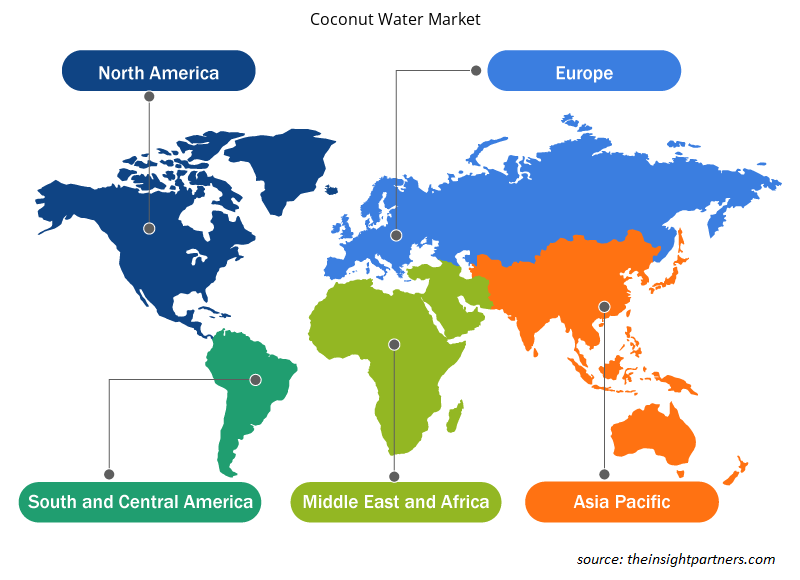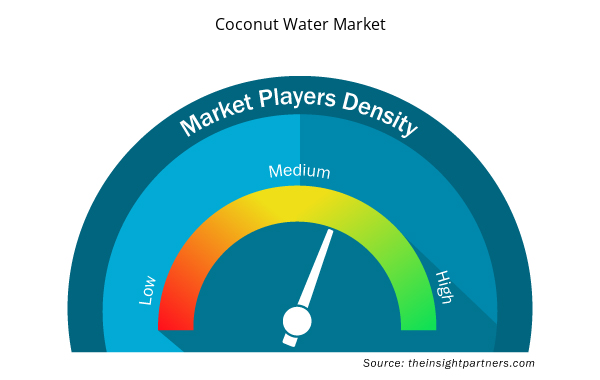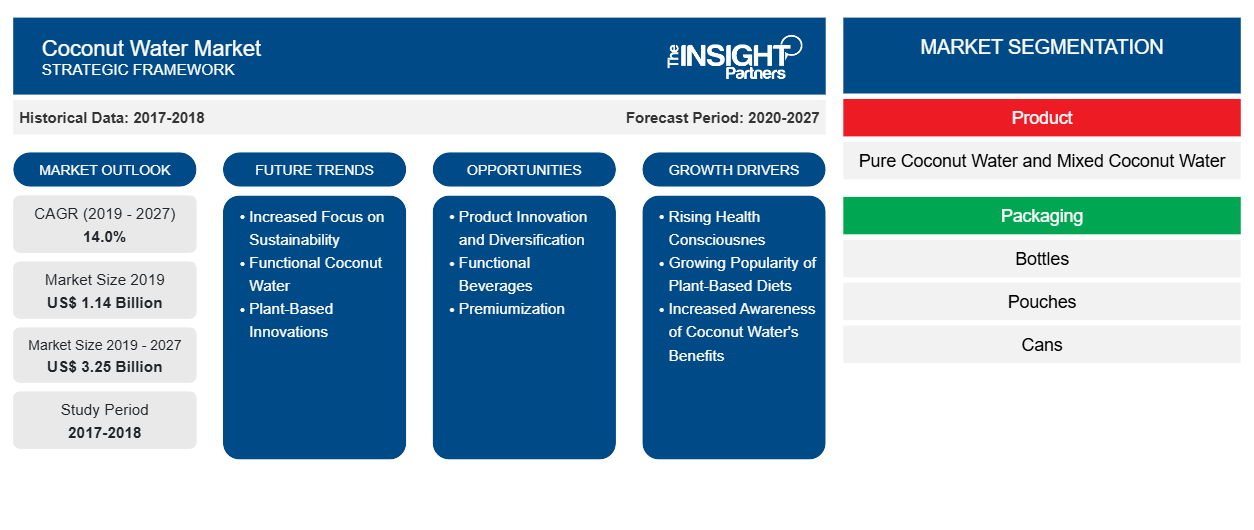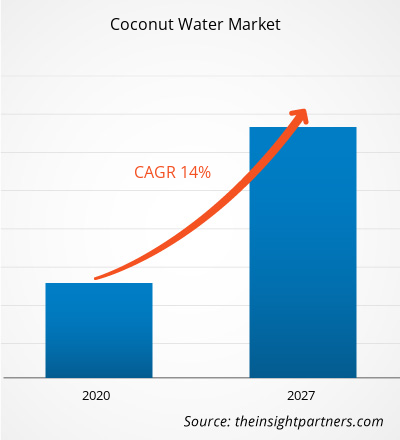Der Markt für Kokoswasser hatte im Jahr 2019 einen Wert von 1.142,09 Millionen US-Dollar und soll bis 2027 einen Wert von 3.246,64 Millionen US-Dollar erreichen; von 2020 bis 2027 wird mit einer durchschnittlichen jährlichen Wachstumsrate von 14,0 % gerechnet.
Kokoswasser wird verwendet, um eine breite Palette von Lebensmitteln und Getränken, darunter Nährstoffriegel, Müsli, Milchprodukte, Backwaren, Getränke, Snacks, Soßen und Suppenrezepte, ernährungsphysiologisch zu funktionalisieren und anzureichern. Es ist kalorienarm und frei von Fett und Cholesterin. Der globale Kokoswassermarkt in Nordamerika wird im Zeitraum 2020–2027 voraussichtlich mit einer durchschnittlichen jährlichen Wachstumsrate von 14,7 % wachsen. Der Konsum von Kokoswasser steigt aufgrund der damit verbundenen gesundheitlichen Vorteile, was das Wachstum des Marktes vorantreibt.
Die COVID-19-Pandemie wurde erstmals im Dezember 2019 in Wuhan (China) gemeldet. Im Juni 2020 gehörten die USA, Russland, Indien, China, Italien, Frankreich und Deutschland hinsichtlich der Anzahl der bestätigten Fälle und der gemeldeten Todesfälle zu den am schlimmsten betroffenen Ländern. Laut den im Juni 2020 aktualisierten Zahlen der WHO wurden weltweit ~7.482.952 bestätigte Fälle und ~419.497 Todesfälle gemeldet. Der Ausbruch hat Volkswirtschaften und Industrien aufgrund von Lockdowns, Reiseverboten und Geschäftsschließungen in Mitleidenschaft gezogen. Die Lebensmittel- und Getränkeindustrie ist eine der weltweit wichtigsten Industrien, die unter schwerwiegenden Störungen in Form von Lieferkettenunterbrechungen, Absagen von Technologieveranstaltungen und Büroschließungen leidet. Obwohl China das globale Produktionszentrum und der größte Rohstofflieferant für verschiedene Industrien der Welt ist, ist es auch eines der am schlimmsten von der COVID-19-Pandemie betroffenen Länder. Die Schließung verschiedener Werke und Fabriken in China wirkt sich nachteilig auf die globalen Lieferketten sowie die Herstellung und den Verkauf verschiedener Lebensmittel- und Getränkeprodukte aus. Der allgemeine Markteinbruch aufgrund dieses Ausbruchs bremst aufgrund von Fabrikschließungen, Hindernissen in den Lieferketten und einem Abschwung der Weltwirtschaft auch das Wachstum des Kokoswassermarktes.
Passen Sie diesen Bericht Ihren Anforderungen an
Sie erhalten kostenlos individuelle Anpassungen an jedem Bericht, einschließlich Teilen dieses Berichts oder einer Analyse auf Länderebene, eines Excel-Datenpakets sowie tolle Angebote und Rabatte für Start-ups und Universitäten.
- Holen Sie sich die wichtigsten Markttrends aus diesem Bericht.Dieses KOSTENLOSE Beispiel umfasst eine Datenanalyse von Markttrends bis hin zu Schätzungen und Prognosen.
Markteinblicke
Gesundheitsvorteile von Kokoswasser treiben Marktwachstum an
Kokoswasser ist cholesterin- und fettfrei. Es gilt als natürliches Sportgetränk aufgrund seines hohen Elektrolytgehalts, darunter Kalium, Kalzium, Natrium und Magnesium, das den Flüssigkeitshaushalt reguliert, Dehydrierung verhindert und eine gute Muskelfunktion gewährleistet. Ein hoher Kaliumgehalt unterstützt auch die Herzgesundheit und schützt den Verbraucher vor Schlaganfallrisiken, indem er den Blutdruck senkt. Ärzte und Ernährungsberater empfehlen Patienten, Kokoswasser anstelle von zuckerhaltigen Getränken zu trinken.dieticians recommend patients to consume coconut water instead of sugary drinks.
Einblicke in Produkttypen
Je nach Produkttyp wird der Kokoswassermarkt weiter in reines Kokoswasser und gemischtes Kokoswasser unterteilt. Das Segment des reinen Kokoswassers hatte 2019 einen größeren Marktanteil. Reines Kokoswasser, auch als Bio-Kokoswasser bekannt, ist gesünder als gemischtes oder herkömmliches Kokoswasser. In seiner natürlichen Form ist es als reichhaltige Quelle für Natrium, Kalium und Magnesium bekannt, die den Rehydrierungsprozess optimieren.rehydration process.
Verpackungsinformationen
Basierend auf der Verpackung ist der Kokoswassermarkt weiter in Flaschen, Beutel und Dosen unterteilt. Das Flaschensegment hatte 2019 den größten Marktanteil. Mit Alternativen von 50 ml bis 1 l war die Flaschenverpackung sowohl bei den Verbrauchern als auch bei den Herstellern eine der beliebtesten Optionen. Die kleinen Flaschen sind leicht zu tragen und können ausreichend Kokoswasser aufnehmen. Flaschen lassen sich auch leicht in großen Mengen transportieren, da sie nicht so leicht beschädigt werden. Versiegelte Flaschenverschlüsse tragen dazu bei, die Haltbarkeit von Kokoswasser um einige Zeit zu verlängern, was die Nachfrage nach abgefülltem Kokoswasser weltweit steigert.
Regionale Einblicke in den Kokoswassermarkt
Die regionalen Trends und Faktoren, die den Kokoswassermarkt im Prognosezeitraum beeinflussen, wurden von den Analysten von Insight Partners ausführlich erläutert. In diesem Abschnitt werden auch die Marktsegmente und die Geografie des Kokoswassermarkts in Nordamerika, Europa, im asiatisch-pazifischen Raum, im Nahen Osten und Afrika sowie in Süd- und Mittelamerika erörtert.

- Erhalten Sie regionale Daten zum Kokoswassermarkt
Umfang des Kokoswasser-Marktberichts
| Berichtsattribut | Details |
|---|---|
| Marktgröße im Jahr 2019 | 1,14 Milliarden US-Dollar |
| Marktgröße bis 2027 | 3,25 Milliarden US-Dollar |
| Globale CAGR (2019 - 2027) | 14,0 % |
| Historische Daten | 2017-2018 |
| Prognosezeitraum | 2020–2027 |
| Abgedeckte Segmente | Nach Produkt
|
| Abgedeckte Regionen und Länder | Nordamerika
|
| Marktführer und wichtige Unternehmensprofile |
|
Marktteilnehmerdichte: Der Einfluss auf die Geschäftsdynamik
Der Markt für Kokoswasser wächst rasant, angetrieben durch die steigende Nachfrage der Endverbraucher aufgrund von Faktoren wie sich entwickelnden Verbraucherpräferenzen, technologischen Fortschritten und einem größeren Bewusstsein für die Vorteile des Produkts. Mit steigender Nachfrage erweitern Unternehmen ihr Angebot, entwickeln Innovationen, um die Bedürfnisse der Verbraucher zu erfüllen, und nutzen neue Trends, was das Marktwachstum weiter ankurbelt.
Die Marktteilnehmerdichte bezieht sich auf die Verteilung von Firmen oder Unternehmen, die in einem bestimmten Markt oder einer bestimmten Branche tätig sind. Sie gibt an, wie viele Wettbewerber (Marktteilnehmer) in einem bestimmten Marktraum im Verhältnis zu seiner Größe oder seinem gesamten Marktwert präsent sind.
Die wichtigsten auf dem Kokoswassermarkt tätigen Unternehmen sind:
- Amy und Brian
- PepsiCo, Inc.
- Die Coca-Cola Company
- C2O Reines Kokoswasser
- Abonnieren
Haftungsausschluss : Die oben aufgeführten Unternehmen sind nicht in einer bestimmten Reihenfolge aufgeführt.

- Überblick über die wichtigsten Akteure auf dem Kokoswassermarkt
Kokoswassermarkt nach Produkttyp
- Reines Kokoswasser
- Gemischtes Kokoswasser
Kokoswassermarkt, nach Verpackung
- Flaschen
- Beutel
- Dosen
Kokoswassermarkt nach Vertriebskanal
- Supermärkte und Hypermärkte
- Gemischtwarenladen
- Online
- Sonstiges
Firmenprofile
- Amy und Brian
- PepsiCo, Inc.
- Die Coca-Cola Company
- C2O Reines Kokoswasser
- Abonnieren
- Green Coco Europe GmbH
- Harmlose Ernte
- Mojo Organics Inc.
- Probieren Sie das Nirvana
- Sambu-Gruppe
- Historische Analyse (2 Jahre), Basisjahr, Prognose (7 Jahre) mit CAGR
- PEST- und SWOT-Analyse
- Marktgröße Wert/Volumen – Global, Regional, Land
- Branche und Wettbewerbsumfeld
- Excel-Datensatz



Report Coverage
Revenue forecast, Company Analysis, Industry landscape, Growth factors, and Trends

Segment Covered
This text is related
to segments covered.

Regional Scope
North America, Europe, Asia Pacific, Middle East & Africa, South & Central America

Country Scope
This text is related
to country scope.
Häufig gestellte Fragen
Pure coconut water, also known as organic coconut water, is healthier as compared to mixed or conventional coconut water. In its natural form, the pure coconut water is known to be a rich source of sodium, potassium, and magnesium that proves to be most beneficial for rehydration.
Amy and Brian, PepsiCo, Inc., The Coca-Cola Company, C2O Pure Coconut Water, Gracekennedy, Green Coco Europe GmbH, Harmless Harvest, Mojo Organics Inc., Taste Nirvana, and Sambu Group are among the well-established players in the global coconut water market.
In 2019,the coconut water market was predominantinAsia Pacificat theglobal level.With an expansion in the number of multinational companies setting up their manufacturing plant in the Asia Pacific region, the market development for these products is anticipated to grow during the forecast period.
Trends and growth analysis reports related to Food and Beverages : READ MORE..
The List of Companies - Global Coconut Water Market
- Amy and Brian
- PepsiCo, Inc.
- The Coca-Cola Company
- C2O Pure Coconut Water
- Gracekennedy
- Green Coco Europe GmbH
- Harmless Harvest
- Mojo Organics Inc.
- Taste Nirvana
- Sambu Group
The Insight Partners performs research in 4 major stages: Data Collection & Secondary Research, Primary Research, Data Analysis and Data Triangulation & Final Review.
- Data Collection and Secondary Research:
As a market research and consulting firm operating from a decade, we have published and advised several client across the globe. First step for any study will start with an assessment of currently available data and insights from existing reports. Further, historical and current market information is collected from Investor Presentations, Annual Reports, SEC Filings, etc., and other information related to company’s performance and market positioning are gathered from Paid Databases (Factiva, Hoovers, and Reuters) and various other publications available in public domain.
Several associations trade associates, technical forums, institutes, societies and organization are accessed to gain technical as well as market related insights through their publications such as research papers, blogs and press releases related to the studies are referred to get cues about the market. Further, white papers, journals, magazines, and other news articles published in last 3 years are scrutinized and analyzed to understand the current market trends.
- Primary Research:
The primarily interview analysis comprise of data obtained from industry participants interview and answers to survey questions gathered by in-house primary team.
For primary research, interviews are conducted with industry experts/CEOs/Marketing Managers/VPs/Subject Matter Experts from both demand and supply side to get a 360-degree view of the market. The primary team conducts several interviews based on the complexity of the markets to understand the various market trends and dynamics which makes research more credible and precise.
A typical research interview fulfils the following functions:
- Provides first-hand information on the market size, market trends, growth trends, competitive landscape, and outlook
- Validates and strengthens in-house secondary research findings
- Develops the analysis team’s expertise and market understanding
Primary research involves email interactions and telephone interviews for each market, category, segment, and sub-segment across geographies. The participants who typically take part in such a process include, but are not limited to:
- Industry participants: VPs, business development managers, market intelligence managers and national sales managers
- Outside experts: Valuation experts, research analysts and key opinion leaders specializing in the electronics and semiconductor industry.
Below is the breakup of our primary respondents by company, designation, and region:

Once we receive the confirmation from primary research sources or primary respondents, we finalize the base year market estimation and forecast the data as per the macroeconomic and microeconomic factors assessed during data collection.
- Data Analysis:
Once data is validated through both secondary as well as primary respondents, we finalize the market estimations by hypothesis formulation and factor analysis at regional and country level.
- Macro-Economic Factor Analysis:
We analyse macroeconomic indicators such the gross domestic product (GDP), increase in the demand for goods and services across industries, technological advancement, regional economic growth, governmental policies, the influence of COVID-19, PEST analysis, and other aspects. This analysis aids in setting benchmarks for various nations/regions and approximating market splits. Additionally, the general trend of the aforementioned components aid in determining the market's development possibilities.
- Country Level Data:
Various factors that are especially aligned to the country are taken into account to determine the market size for a certain area and country, including the presence of vendors, such as headquarters and offices, the country's GDP, demand patterns, and industry growth. To comprehend the market dynamics for the nation, a number of growth variables, inhibitors, application areas, and current market trends are researched. The aforementioned elements aid in determining the country's overall market's growth potential.
- Company Profile:
The “Table of Contents” is formulated by listing and analyzing more than 25 - 30 companies operating in the market ecosystem across geographies. However, we profile only 10 companies as a standard practice in our syndicate reports. These 10 companies comprise leading, emerging, and regional players. Nonetheless, our analysis is not restricted to the 10 listed companies, we also analyze other companies present in the market to develop a holistic view and understand the prevailing trends. The “Company Profiles” section in the report covers key facts, business description, products & services, financial information, SWOT analysis, and key developments. The financial information presented is extracted from the annual reports and official documents of the publicly listed companies. Upon collecting the information for the sections of respective companies, we verify them via various primary sources and then compile the data in respective company profiles. The company level information helps us in deriving the base number as well as in forecasting the market size.
- Developing Base Number:
Aggregation of sales statistics (2020-2022) and macro-economic factor, and other secondary and primary research insights are utilized to arrive at base number and related market shares for 2022. The data gaps are identified in this step and relevant market data is analyzed, collected from paid primary interviews or databases. On finalizing the base year market size, forecasts are developed on the basis of macro-economic, industry and market growth factors and company level analysis.
- Data Triangulation and Final Review:
The market findings and base year market size calculations are validated from supply as well as demand side. Demand side validations are based on macro-economic factor analysis and benchmarks for respective regions and countries. In case of supply side validations, revenues of major companies are estimated (in case not available) based on industry benchmark, approximate number of employees, product portfolio, and primary interviews revenues are gathered. Further revenue from target product/service segment is assessed to avoid overshooting of market statistics. In case of heavy deviations between supply and demand side values, all thes steps are repeated to achieve synchronization.
We follow an iterative model, wherein we share our research findings with Subject Matter Experts (SME’s) and Key Opinion Leaders (KOLs) until consensus view of the market is not formulated – this model negates any drastic deviation in the opinions of experts. Only validated and universally acceptable research findings are quoted in our reports.
We have important check points that we use to validate our research findings – which we call – data triangulation, where we validate the information, we generate from secondary sources with primary interviews and then we re-validate with our internal data bases and Subject matter experts. This comprehensive model enables us to deliver high quality, reliable data in shortest possible time.


 Holen Sie sich ein kostenloses Muster für diesen Bericht
Holen Sie sich ein kostenloses Muster für diesen Bericht